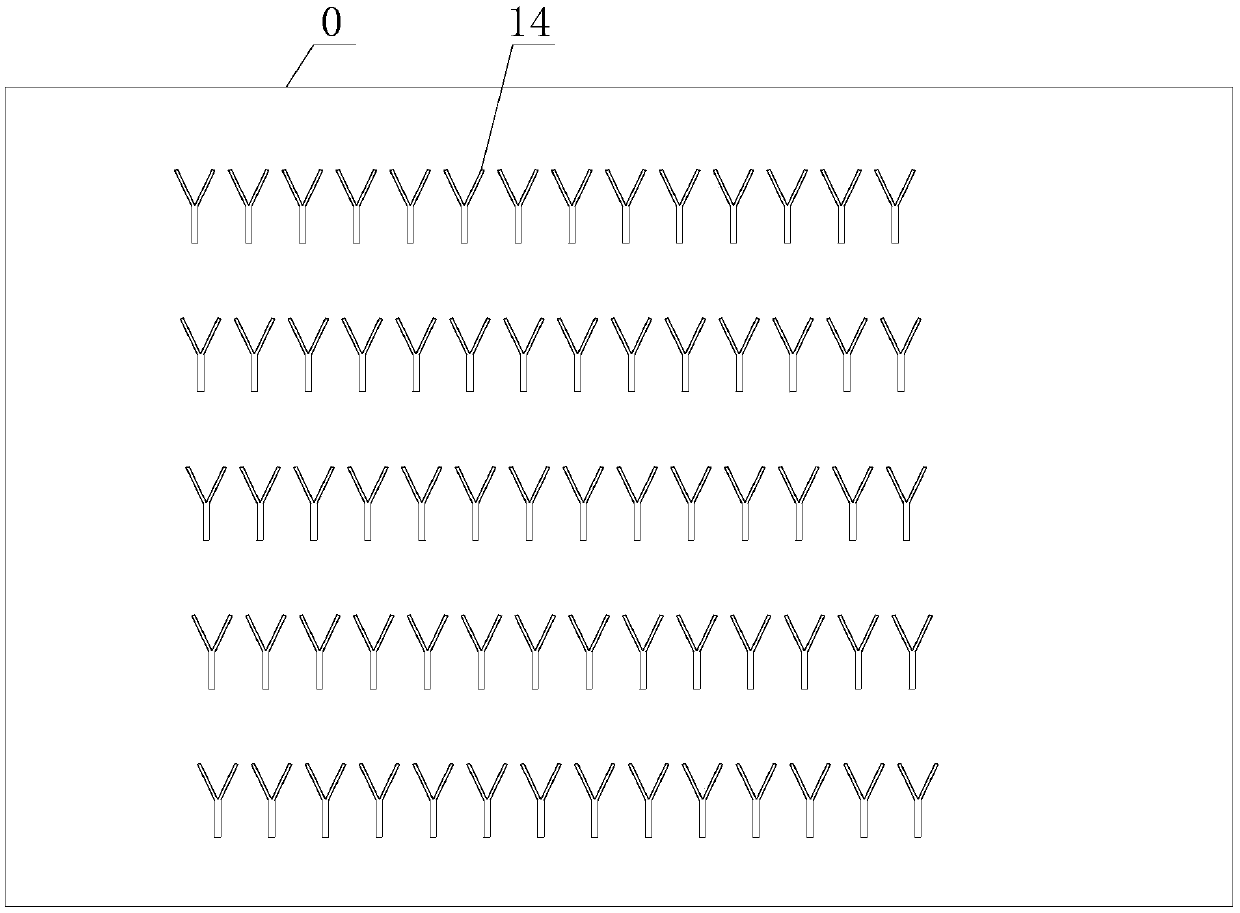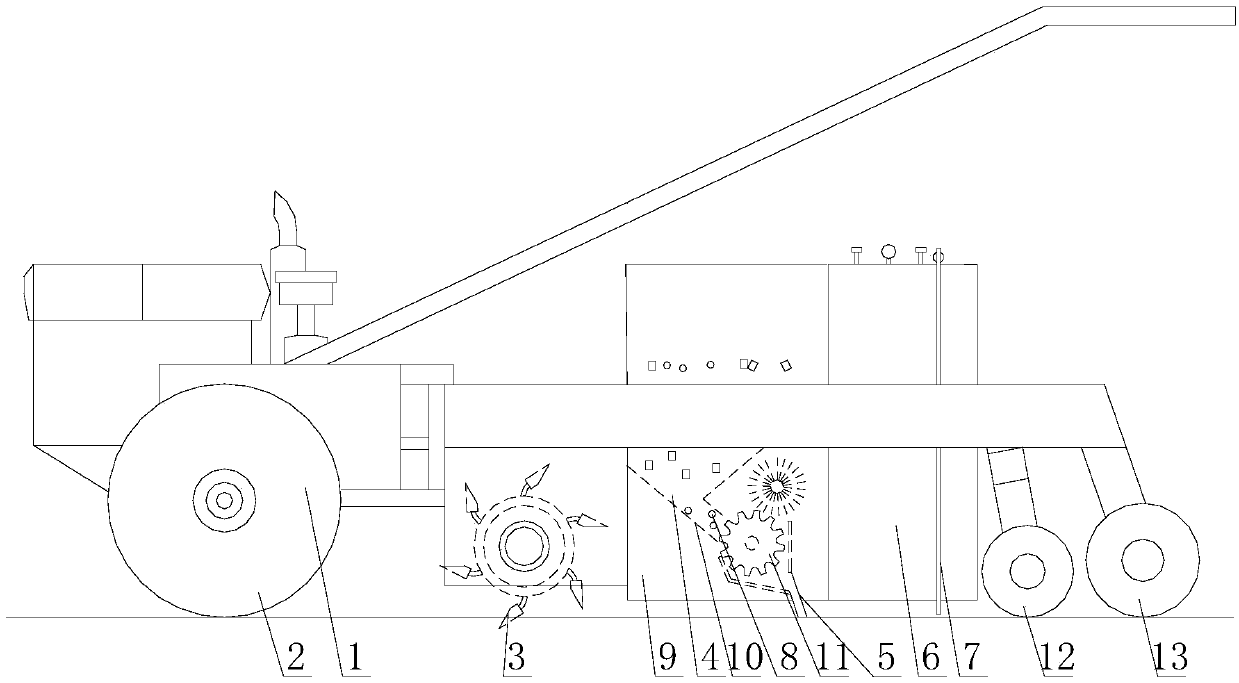Gathering and elimination implementation method for greenhouse soil nematodes
A technology for soil nematodes and greenhouses, which is used in devices, applications, and animal husbandry to capture or kill insects. Speed, the effect of reducing soil damage
- Summary
- Abstract
- Description
- Claims
- Application Information
AI Technical Summary
Problems solved by technology
Method used
Image
Examples
Embodiment 1
[0025] Embodiment 1, the method comprises the steps:
[0026] A. If figure 1 As shown, water spinach is sown in columns in greenhouse 0; the plants 14 in the embodiment of the present invention are all water spinach, and water spinach belongs to dwarf leafy vegetables, which is convenient for the entry of ditching and spreading devices in the later stage. Compared with grapes and passion fruit The growth cycle is short, the cost is low, and the vine frame does not need to be removed. On the other hand, water spinach is heat-resistant and suitable for summer growth.
[0027] B. Detect the soil at the root of water spinach. When cysts are formed in the root of water spinach, it indicates that nematodes gather in the root of water spinach, which indicates that it is suitable for the operation of stuffy shed. According to the adjustment of the period from sowing to cyst formation, the time of stuffy shed is controlled in mid-July , water the soil in the greenhouse 0, keep the soi...
Embodiment 2
[0041] Embodiment 2 is basically the same as Embodiment 1, the only difference is that a method for inhibiting soil nematodes in greenhouses, the method comprises the following steps:
[0042] A. Sowing water spinach by column in greenhouse 0;
[0043] B. According to the adjustment of the cycle from sowing to cyst formation, the time of stuffy shed is controlled at the end of July, and the soil is watered in greenhouse 0, and the soil humidity is kept at 80-85%. The temperature can reach 60-80℃, and the time of stuffy shed is 7 days;
[0044] C. Open the greenhouse to release heat, and the heat release time is 2 hours;
[0045] D, ditching the soil surface in the greenhouse 0, spreading cooling materials and covering soil, making the soil temperature drop instantaneously, the depth of ditching is 18cm, wherein the cooling materials are dry ice and liquid nitrogen, and the usage amount of dry ice is 150kg / mu. The usage rate of liquid nitrogen is 100kg / mu.
[0046] E. Cover ...
Embodiment 3
[0048] Embodiment 3 is basically the same as Embodiment 1, the only difference being that it is a method for suppressing soil nematodes in greenhouses, the method comprising the steps of:
[0049] A. Sowing water spinach by column in greenhouse 0;
[0050] B. According to the adjustment of the cycle from sowing to cyst formation, the time of controlling the stuffy shed is in mid-August, water the soil in the greenhouse 0, and keep the soil humidity at 80-85%. The temperature can reach 60-80 ℃ and the time of stuffy shed is 8 days;
[0051] C. Open the greenhouse to release heat, and the heat release time is 3 hours;
[0052] D, ditching the soil surface in the greenhouse 0, spreading cooling materials and covering soil, so that the soil temperature drops instantaneously, the depth of ditching is 20cm, wherein the cooling materials are dry ice and liquid nitrogen, and the usage amount of dry ice is 130kg / mu. The consumption of liquid nitrogen is 110kg / mu.
[0053] Experiment...
PUM
 Login to View More
Login to View More Abstract
Description
Claims
Application Information
 Login to View More
Login to View More - R&D
- Intellectual Property
- Life Sciences
- Materials
- Tech Scout
- Unparalleled Data Quality
- Higher Quality Content
- 60% Fewer Hallucinations
Browse by: Latest US Patents, China's latest patents, Technical Efficacy Thesaurus, Application Domain, Technology Topic, Popular Technical Reports.
© 2025 PatSnap. All rights reserved.Legal|Privacy policy|Modern Slavery Act Transparency Statement|Sitemap|About US| Contact US: help@patsnap.com



